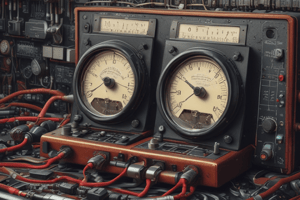Podcast
Questions and Answers
What is the purpose of connecting a resistance in series with a galvanometer when converting it to an ammeter?
What is the purpose of connecting a resistance in series with a galvanometer when converting it to an ammeter?
- To increase the sensitivity of the galvanometer
- To protect the galvanometer from low currents
- To increase the effective current capacity of the galvanometer (correct)
- To decrease the effective resistance of the galvanometer
Which of the following statements accurately describes the function of a shunt in an ammeter?
Which of the following statements accurately describes the function of a shunt in an ammeter?
- It diverts a portion of the current away from the galvanometer (correct)
- It completely isolates the galvanometer from the circuit
- It allows all current to flow through the galvanometer
- It increases the resistance of the galvanometer
In an ideal ammeter, what should its effective resistance be?
In an ideal ammeter, what should its effective resistance be?
- High resistance to limit current flow
- Infinite resistance to prevent current
- Variable resistance for different current levels
- Zero resistance (correct)
What is the relationship between the total current (I) and the current through the galvanometer (Ig) when a shunt is used?
What is the relationship between the total current (I) and the current through the galvanometer (Ig) when a shunt is used?
How does the shunt affect the range of an ammeter?
How does the shunt affect the range of an ammeter?
Flashcards
Converting Galvanometer to Ammeter
Converting Galvanometer to Ammeter
Modifying a galvanometer to measure current, involving increasing current capacity, decreasing resistance, and protecting against excessive current.
Shunt
Shunt
A low resistance connected in parallel with a galvanometer to divert current, protect it, and increase the ammeter's range.
Effective Resistance (G)
Effective Resistance (G)
The combined resistance of the galvanometer and shunt, determining how much current the ammeter allows.
Current through Shunt (Is)
Current through Shunt (Is)
Signup and view all the flashcards
Ammeter's Range
Ammeter's Range
Signup and view all the flashcards




